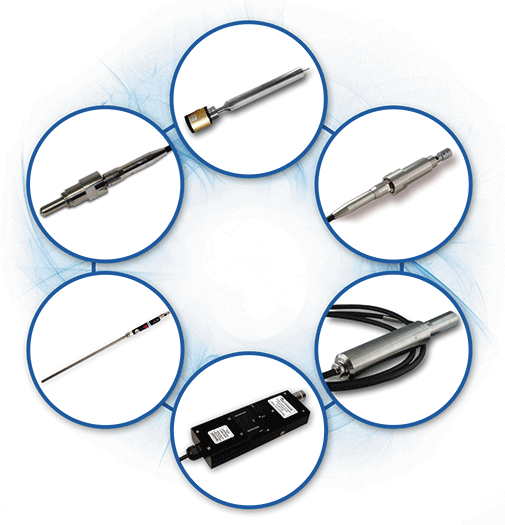Sampling Flexibility for Raman Spectroscopy
Special Issues
Sampling flexibility is a significant benefit of Raman spectroscopy.
Key Issues:
- Sampling flexibility of Raman enables in-process analysis of solids, turbid media, liquids, and gases
- Large volumetric Raman provide representative sampling of heterogenous solids
Raman spectroscopy is an analysis technique that provides a "molecular fingerprint" of the sample, enabling analysis of chemical composition and molecular structure without sample preparation. As a measurement technique, Raman imparts application and financial benefits from laboratory discoveries to feedback-control in manufacturing. In situ real-time analysis, compatibility with aqueous systems, nondestructive nature, and high chemical specificity means that a Raman-analyzed sample is representative of the process. Because Raman is a nondestructive technique, the same sample measured by Raman can also be measured by other analytical techniques. These well-known features have been harnessed in pharmaceutical, chemical, polymer, and bioprocessing industries.
Sampling Flexibility in Raman
Fiber optic sampling probes enable real-time Raman measurements outside the laboratory. For process or in-line sampling applications, fiber optic probes can be inserted directly in the process. Figure 1 shows variants of fiber-optic probes used in Raman spectroscopy. The sampling flexibility imparted by fiber optic probes means that Raman spectroscopy can be applied to real-time in situ analysis of a variety of materials for applications from early development to manufacturing. The design of fiber optic probes for process environments takes into account additional considerations of the material's phase, the ability to be immersed in corrosive or hazardous environments, and laser safety.

Figure 1: Raman measurements outside of a laboratory setting is achieved through fiber optic sampling probes. Sampling probes for Raman spectroscopy enable offset analysis of solids, thin films, and raw materials, or immersion analyses in liquids or gases without needing to customize process hardware.
In-process Raman in Solids and Turbid Media
For processes that involve solids or turbid media, optical scattering is an important material property that needs to be considered. Understanding the effects of optical scattering on Raman signal recovery will guide the selection of a fiber-optic probe, because there are applications in which optical scattering can be harnessed to maximize sampling volume and there are other applications in which the effects of optical scattering should be minimized. In a recent example of Raman-based control in a process with solid materials, a large volumetric Raman probe was used to acquire information on critical quality attributes of pharmaceutical granules during a continuous blending and tableting process (1). Raman data were acquired quickly and nondestructively and with great chemical specificity, showing that Raman provides detailed in situ process knowledge needed for real-time process understanding.
Conclusion
Sampling flexibility is a significant benefit of Raman spectroscopy. The use of fiber-optic probes expands the capability of an analyzer to meet current and future application needs. Raman provides detailed chemical information without sample homogenization, enabling bulk or cross-sectional analysis during the process. Raman spectroscopy approaches to measuring layered samples may be applied to pharmaceutical tablets, copolymers, or biological materials such as cells or engineered scaffolds. Scientifically and financially successful Raman applications have been demonstrated at all scales, from the laboratory to on-line in manufacturing in PAC and PAT environments. Examples of processes benefiting from Raman spectroscopy include:
- Pharmaceutical formulations: blending, granulation, coating, drying, tableting, content uniformity
- Pharmaceutical API: reaction chemistry, yield, polymorph form identification, crystallization
- Polymer: polymerization blending, extrusion monitoring, crystallinity, density, copolymers
- Bioprocessing: cell culture, fermentation
References
(1) B. Nagy et al., "In-line Raman spectroscopic monitoring and feedback control of a continuous twin-screw pharmaceutical powder blending and tableting process," Int. J. Pharm. 530, 21–29 (2017).

Kaiser Optical Systems
371 Parkland Plaza, Ann Arbor, MI 48103
tel. (734) 665-8083
Website: www.kosi.com

New Study Reveals Insights into Phenol’s Behavior in Ice
April 16th 2025A new study published in Spectrochimica Acta Part A by Dominik Heger and colleagues at Masaryk University reveals that phenol's photophysical properties change significantly when frozen, potentially enabling its breakdown by sunlight in icy environments.
Advanced Raman Spectroscopy Method Boosts Precision in Drug Component Detection
April 7th 2025Researchers in China have developed a rapid, non-destructive Raman spectroscopy method that accurately detects active components in complex drug formulations by combining advanced algorithms to eliminate noise and fluorescence interference.